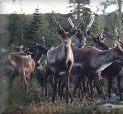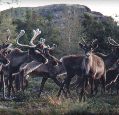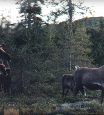







The caribou is a member of the deer family and is circumpolar in its dibution. Caribou are inhabitants of the arctic tundra, alpine tundra, and the northern boreal forests of North America, Russia, Norway, Sweden, and Finland. In the European countries, caribou are called reindeer, but in Alaska and Canada only the domestic forms of the species such as those at the delta of the Mackenzie River, N.W.T, and on the Seward Peninsula of Alaska are known by that name.
Distribution
The caribou of North America and the reindeer of northern Europe and Asia belong to a single species, Rangifer tarandus. Currently, four native subspecies are recognized in North America. In addition, an introduced herd of European reindeer, Rangifer tarandus tarandus, is now established in the Mackenzie Delta region.
Appearance
The caribou is a largesized deer with a slightly elongated head and trunk. The muzzle is large and blunt, the ears short and broad, the tail short. Caribou usually carry their heads low except when alarmed, then both head and tail are carried high. The large, crescentshaped hooves have sharp edges which ensure good footing, and the hooves spread widely to support the animal when walking on snow or boggy terrain. The dew claws provide additional support and leave a characteristic imprint which is useful in identifying caribou tracks. Adult males weigh about 400 to 600 lb. The dense coat has long, brittle guard hairs and a close, fine, crinkley undercoat. Colouration and pattern vary with age, sex and season; generally the body is dark brown, the mane (pronounced in males), neck, belly and rump are whitish, the legs are brown except for white "socks" above the hooves. Although both sexes usually have antlers, the antlers of adult males are massive compared to those of females, in addition not all females in a herd develop antlers. A distinctive feature of the erect spreading antlers of adult males is the palmate brow tine(s) which point(s)forward and downward over the forehead.
Life History
Caribou are a social and highly gregarious species. Like most northern animals, caribou calves are born in late May and early June when more abundant and nutritious food is available for the lactating cow and growing fawn. Caribou calves are darkbrown or white. The breeding season is in late autumn. Bulls may breed at oneandahalf years of age and are aggressively polygamous. A mature dominant bull may collect and defend a group of 30 cows although harems of five or six females are more common. The gestation period averages about seven to eight months and single births are generally the case for the species.
Food Habits
Caribou are primarily grazers and display selective feeding habits, taking only the most palatable portions of selected forage, which includes a variety of forbs, grasses, and shrubs. Summer foods include various grasses, sedges, horsetails, a variety of flowering plants and the leaves of willow and dwarf birch. During the winter, when snow is deep, winter foliose lichens become a major food item, although weather-dried grasses, sedges, willow and birch tips are taken where available.
Antlers
The growth and shedding of antlers varies with the age, sex and physiological condition of the individual animal. Adult males lose their antlers during early winter just after the end of the rut and grow a new rack in the following spring and summer. Caribou cows, on the other hand, drop their antlers in late spring prior to calving time Pregnant cows, however, retain their antlers longer than other adults, dropping them usually after the calves have been born. Young bulls may carry their antlers into early spring before shedding, and calves carry their small spikes into early summer of the year following their birth. The softgrowing antlers are covered with "velvet." The velvet is scraped off by rubbing and jousting with shrubbery once the antlers have hardened. When the antlers are completely hardened and bleached, the bulls joust among themselves, and with the approach of the rut, compete for harems of cows. Usually bulls with the largest antlers are socially the more dominant animals at the rut and therefore, of all males, the most reproductively fit.
QuebecLabrador Caribou Bowhunting Caribou Back to Caribou Home Page
BOWHUNTING Canada ®
PO Box 649, Lundar, MB R0C-1Y0, Canada
Phone: (204) 762-6133